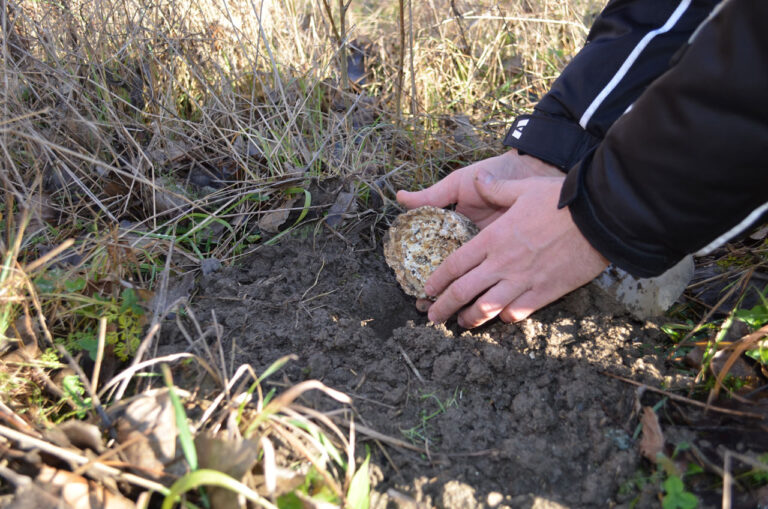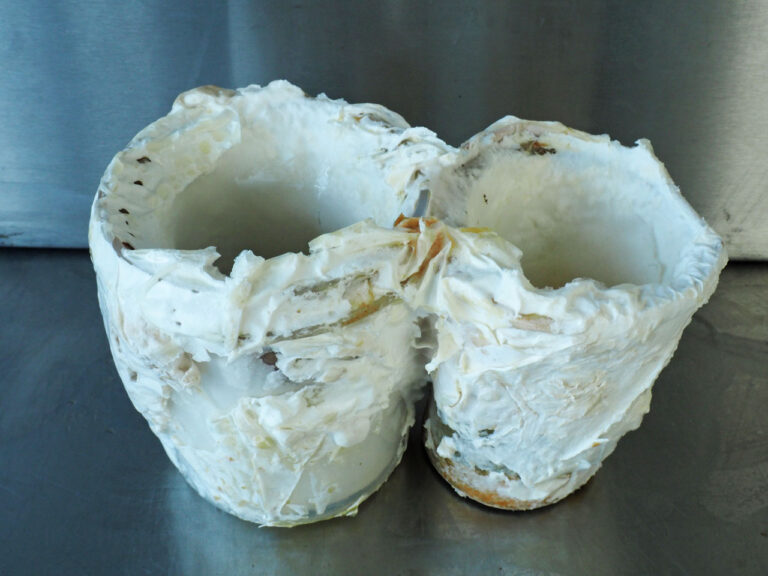
Through experiments, we found that oil liquids (where one drop pollutes even a thousand liters of drinking water) can be broken down and destroyed by means of selected types of fungi. These experiments were carried out on Petri dishes and in selected substrates. On the basis of proven conclusions and recognized principles, we can set up a technological process and mechanism that will purposefully destroy the ecological disasters of contamination of soil and water with oil substances.
The selected line of DUUGY ecological packaging is designed in such a way that it becomes an integral part of the product, where the fungus in the packaging is active and, if the specified conditions are observed, grows from the packaging into the core of the selected daily consumption product. We have tested a wide portfolio of daily consumption products, where this process is not available and at the same time it is possible to apply this process and thus increase the uniqueness of common daily consumption products by active substances of medicinal mushrooms such as rare beta and alpha glucans, minerals, proteins and other rare substances of medicinal mushrooms in natural form while respecting the principles as they developed in nature for a billion years.

The entire process of establishing cultures, in the video gallery below.
Many studies report the remarkable ability of certain microorganisms, including bacteria and fungi, to rapidly degrade biodegradable polymers based on bio- and fossil fibers under stressful conditions by producing enzymes and their products [1, 3, 4, 22, 24, 26, 27, 31, 41, 45, 46, 55, 60, 64, 67, 73, 75, 76, 77]. Although many reports describing microbial communities degrading chemical additives have been published, no enzymes are known to act on the high molecular weight polymers polystyrene, polyamide, polyvinyl chloride, polypropylene, ether-based polyurethane, and polyethylene. Together, these polymers make up more than 80% of the annual plastic production [14]. Microbial degradation of plastics is a promising ecological strategy that represents a great opportunity to manage waste plastic materials without negative impacts [8]. The biodegradation activity of most enzymes is higher in fungi than in bacteria. Fungal genera include Aspergillus, Cunninghamella, Mucor, Paecilomyces, Paraphoma, Penicillium, Phaenarochete, Pestalotiopsis and Pseudozyma [6, 35, 36, 51, 52, 61, 68, 80]. The ability of laser-induced plasma as a new technique to increase the efficiency of starch-based plastic polymer degradation by fungi was tested. The most effective fungus in the degradation of starch-based plastic polymer was Aspergillus niger [21]. Exposure to gamma radiation resulted in weakening of the bonds, making it easier for endophytic fungi to colonize the polymer [74]. Fungi are also involved in the biodegradation of plastics in the marine environment [15, 23, 34, 42, 56, 66, 82].
A biodegradable plastic-degrading enzyme (cutinase) from Aspergillus oryzae has been purified and characterized [38].
Biodegradable plastics are susceptible to degradation by enzymes produced by microorganisms including bacteria, fungi and algae [29]. Fungal communities on biodegradable plastics – poly-(ϵ-caprolactone) (PCL), poly-(butylene succinate) (PBS), poly-(butylene succinate and adipate) (PBSA) and poly-lactide (PLA) were studied in two Japanese soils [28]. Pleurotus ostreatus degrades oxo-biodegradable plastics and produces fruiting bodies using this plastic as a substrate [16, 17]. Temperature is the predominant parameter controlling the degradation of PLA by fungi [63]. To improve the biodegradation of biodegradable plastic mulch films, 1227 fungal strains were isolated from the surface of plants and the ability to degrade the mulch films was evaluated [32]. Most of the culturable soil fungi that colonized biodegradable mulches belonged to the family Trichocomaceae (which includes beneficial, pathogenic and mycotoxic species of the genera Aspergillus and Penicillium) [47].
Nylon 6 is one of the synthetic polymers that has a lot of use in the environment and has been found to be a tough plastic to degrade. According to one study, it can be degraded by Trametes versicolor [11].
PE is the most abundant non-degradable plastic waste and represents a constant and serious threat to the entire ecosystem [78, 83]. The best way to reduce the problem caused by polyethylene is its biodegradation [79]. Microorganisms including Fusarium graminearum produced depolymerizing enzymes during the biodegradation of PE carrier bag [20]. The ability of fungi and Streptomyces species to attack degradable plastics was investigated in clean shake flask culture studies. The degradable plastic used in this study was disposable polyethylene bags containing 6% starch [18]. Manganese peroxidase is a key enzyme in the degradation of polyethylene by lignin-degrading fungi [25]. The most effective PE-exacerbating fungal isolates were identified as Aspergillus terreus and Aspergillus sydowii using both morphological keys and molecular tools [65]. The effectiveness of microbial species from mangrove soils in degrading plastics and polyethylene was analyzed in shaker cultures. Aspergillus glaucus degraded 28.80% of polyethylene and 7.26% of plastics in one month [30]. Recent data have shown that biodegradation of LDPE waste with selected microbial strains has become a viable solution. Among biological agents, microbial enzymes are one of the most powerful tools for LDPE biodegradation [30]. Fungal strains colonized the surface of LDPE and caused some physical changes [57]. Eight strains of fungi were isolated from the solid waste and identified. All these fungal strains were able to adhere to the surface of the LDPE film and grow in a synthetic medium supplemented with 0.1% LDPE because they used it as the sole source of carbon and energy [33]. Aspergillus niger and A. japonicus were selected for the degradation of polyethylene under laboratory conditions. Aspergillus japonicus showed 12% degradation potential compared to A. niger with 8% degradation in one month [59]. Physicochemically treated PE films were found to be more effectively degraded by fungal isolates than untreated films [39]. The level of biodegradation of LDPE packaging with bacterial and fungal inocula (including the genus Aspergillus) from different sampling sites in Nairobi was evaluated under laboratory conditions [49]. Two potential fungal strains, Penicillium oxalicum and Penicillium chrysogenum, which have the ability to degrade HDPE and LDPE, were isolated [53]. The ability of Phanerochaete chrysosporium to increase the biodegradation of polyethylene film in soil microcosms was evaluated [54]. PE can also be degraded by Penicillium simplicissimum [84].
Eight-week incubation of PS with Cephalosporium sp. and Mucor sp. showed a significant decrease in PS weight [10]. Basidiomycetes causing white rot were able to biodegrade styrene (1-phenylethylene) graft copolymers of lignin containing different proportions of lignin and polystyrene [44]. PS plastic films were mineralized by the fungus Penicillium variabile. Ozonation pretreatment significantly increased the biodegradation of PS [81].
Some authors report the use of filamentous fungi for the degradation of polyurethane and also report some properties of the enzymes involved in it [37]. Different fungi are associated with PU degradation in different soils, but the physical process is independent of the soil type [13]. High numbers of fungi and bacteria were recovered from biofilms on pieces of polyester PU buried in soil, including Nectria gliocladioides, Penicillium ochrochloron and Geomyces pannorum [5]. Isolates of Pestalotiopsis microspora were uniquely able to grow on polyester PU as the sole carbon source under both aerobic and anaerobic conditions. Molecular characterization of this activity suggests that serine hydrolase is responsible for polyester PU degradation. Wheat colonized by the fungi Nectria haematococca, Penicillium viridicatum, P. ochrochloron and Mucormycotina sp. increased PU degradation compared to non-colonized wheat [12]. More than a hundred fungal strains were isolated from the plastic remains of the shores of Lake Zurich in Switzerland, of which only three – Cladosporium cladosporioides, Xepiculopsis graminea and Penicillium griseofulvum – showed the ability to degrade PU. A series of other mushrooms, with origins other than plastic residues, were also tested. Here, only two saprotrophic fungi – Agaricus bisporus and Marasmius oreades – demonstrated the ability to degrade PU [7]. Incubation of PU with Aspergillus flavus resulted in a 60.6% reduction in PU weight [43].
It was concluded that isolated strains of fungi Phanerochaete chrysosporium, Lentinus tigrinus, Aspergillus niger and A. sydowii have significant potential for biodegradation of PVC plastics [2].
It is necessary to take into account the influence of abiotic factors on the material performance of WPC [69, 70, 71]. Testing the material properties of wood-plastic composites (WPC) requires an adequate and time-efficient evaluation of the resistance against colonization and destruction by fungi [50]. The ability of white and brown rot fungi to colonize wood-plastic composites was investigated by measuring weight loss and anatomical changes. A material containing a 70/30 wood-high density polyethylene (HDPE) blend was most susceptible to fungal attack, while two different 50/50 wood-HDPE composites experienced little or no attack. [40]. The fungus Fuscoporia ferrea was effective in the surface colonization of WPC, with higher weight loss and even the appearance of reproductive structures after the incubation period [9]. Trametes versicolor produced significantly higher weight losses on HDPE/poplar composites, while Douglas fir-based WPCs were less susceptible to this fungus [19].